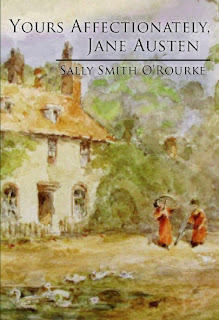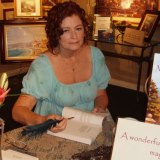By Yours Affectionately, Jane Austen author Sally Smith O’Rourke
Was Mr. Darcy real?
In this year, the 200th anniversary of Jane Austen’s Pride and Prejudice, it seems a relevant question. In reading biographies of Jane Austen it becomes apparent that the famed author based virtually all of the characters in her books on the people in her life. Some, like friends and family, were people with whom she was very close, some were neighbors, others were merely passing acquaintances and very likely there were people she had never met but had observed.
The one character that most Austen biographers have never been able to identify is Mr. Darcy. There are many theories, of course, but unlike virtually all her other characters Mr. Darcy of Pemberley remains an enigma.
Fitzwilliam Darcy was different in 1813 when the literary world met him for the first time and he is different today. A man of his stature and wealth would very likely, even today, have simply walked away from a rejection such as Elizabeth Bennet’s. Never having been told no and used to people bowing to his every whim he is initially shocked and angered by such impertinence; but ultimately he is dissatisfied with himself. Humbled by her reproof, “had you behaved in a more gentlemanlike manner,’ he makes a concerted effort to change, not to win Elizabeth’s hand, but to become a man able to please a woman worthy of being pleased. Darcy is the ultimate romantic lead because he altered his perceptions and prejudices. How Austen came to write so uncommon a man for any time intrigued me and sent me on the journey that brought about the creation of The Man Who Loved Jane Austen.
Perhaps I should start at the beginning, in 1999 my late husband, Michael and I vacated our home at the recommendation of the Health Department because the house was harboring toxic mold. In an attempt to redirect what had become an obsession with the house and resulting law suit, we sat down one night and watched the wonderful Andrew Davies adaptation of Pride and Prejudice made for BBC/A&E; all five hours of it in one sitting. In continuing our non-obsession plan I re-read the book and then all of Austen’s other writings and became fascinated with the author herself. Not only had she created the inimitable Mr. Darcy but heroines that were strong and independent. That may not sound like a big deal today but in the early nineteenth century it most definitely was a big deal.
By the time I had finished reading all six of Austen’s novels and three biographies Mike was ready to start a new project and suggested that we resurrect a time travel story I’d started a few years before but never finished. However, I suggested something else entirely.
To me Mr. Darcy always seemed more a modern man than a Regency aristocrat. Here was a man whose offer of marriage was rejected, and none too gently, by a woman he deemed socially inferior. Later admitting to anger, certainly a natural human reaction he still looks into himself and decides she was right. He is a jerk. Determining that she isn’t inferior at all he sets out to change that part of him that made Elizabeth Bennet, a woman worth pleasing, not at all pleased with him and does so with no expectation of any kind other than to better himself.
In an era when women were second class citizens, to be used by rich and powerful men as bargaining chips, chattel to bear heirs to keep the wealth and power in the family, Jane Austen’s men where exceedingly unusual; the men in her books and in her life. Her father and brothers encouraged and supported her writing. Her heroes loved women who were strong and intelligent.
In our hands Darcy became a Virginia horse breeder whose family history stretches back to the revolution. On a trip to England to purchase, Lord Nelson, a champion jumper, Darcy is injured when thrown from the horse and wakes up in Jane Austen’s bed. So begins his journey to 1810.
Darcy couldn’t have a permanent relationship with Austen so we created Eliza Knight, successful New York artist. Eliza triggers the story in The Man Who Loved Jane Austen when she finds two letters in an antique vanity. One is an opened letter from an F. Darcy to Jane Austen and the other, sealed with a fanciful letter ‘A’, to Fitzwilliam Darcy from Jane Austen.
Even though Mike was a published author (dark fiction as Michael O’Rourke and political thrillers as F.M. O’Rourke) we made no attempt to get the book published and I can’t really tell you why. I don’t know if time has stripped me of the memory or if it just wasn’t important. We had written the book for us. Mike called it the ultimate valentine because it came out of the love we had for each other. So after completing the manuscript, we type-set, printed and hand-bound copies of it and gave them as gifts to family and friends. Then my world crashed and burned. In November 2001, two weeks before his sixtieth birthday Mike died suddenly; we had not gotten out of the house soon enough.
The Man Who Loved Jane Austen sat on the shelf for several years while I struggled through the grief and worked at putting my life back together. Once I was thinking straight again I realized that I didn’t want our little story to die with Mike.
The Man Who Loved Jane Austen was published in 2006. The publisher didn’t want two names on the cover (which was how I had presented it) and preferred the one name be mine as I would be doing revisions and promotions. So only my name appears on the cover of the book. I often regret not insisting that Mike’s name be used as a tribute to him. But regret serves no useful purpose and people from all over the world have read and enjoyed his work and that was my objective.
Henry Austen said of his sister, Jane that her single most important trait was that she was thoroughly religious and devout; that she feared giving offence to God and incapable of feeling it toward any fellow creature. I described her as a true Christian in Yours Affectionately, Jane Austen and I have no doubt that she was. That said; why did her sister Cassandra feel the need to edit Jane’s letters before distributing them to nieces and nephews?
Jane wrote prayers asking God to help suppress evil thoughts and inclinations, to grant temper of forbearance and patience, to think humbly of ourselves, be severe only in the examination of our own conduct, considering fellow creatures with kindness and to judge all with charity. As with all of us Jane most likely had some not so charitable thoughts and may very well have written them in letters, something her sister did not want future generations of the family to see. Certainly she thought she was protecting Jane’s legacy whether it was necessary or not.
An English friend told us, after reading The Man Who Loved Jane Austen, that it was the first time he had ever thought of Austen as a real person. To him she was an icon who was not particularly interesting. I think Cassandra’s attempts to create a perfect personification for Jane really did her sister a disservice when she was such a wonderful, inventive and interesting individual.
I’ve often wondered if Cassandra’s zeal in protecting Jane’s memory included the destruction of journals. Here was a woman who wrote regularly, thousands of letters (although only 160 remain), a history, poems, prayers; she even wrote sermons for James, her eldest brother. How was it possible that she kept no diary or journal of any kind? A question, I’m afraid, that will never be answered.
At one time I thought it would be fun to create such a journal, ostensibly written by Austen. Specifically a chronicle of the five days Fitzwilliam Darcy of Pemberley Farms, Virginia spent in Hampshire the spring of 1810 from The Man Who Loved Jane Austen. After several false starts and an overwhelming feeling of pretention (who was I pretending to be Jane Austen?) I wrote an entry that ended with ‘Jane’ writing, I wonder what Mr. Darcy is doing at this moment and Yours Affectionately, Jane Austen was born.
Yours Affectionately, Jane Austen takes place for Jane, the summer of 1813 after the publication and success of Pride and Prejudice as well as the second edition of Sense and Sensibility for which Jane had received some celebrity as people in her circle and outside discovered who ‘The Lady’ credited with the books really was. For Darcy it is the week following his heritage Rose Ball in present day Virginia.
Researching a letter she found from Jane Austen to Fitzwilliam Darcy takes Manhattan artist Eliza Knight to a centuries old Virginia estate, Pemberley Farms. There she meets Fitz Darcy, his tale of love and romance in Regency England leaves Eliza in no doubt that he is the embodiment of Jane Austen’s legendary hero. And she’s falling in love with him. But can the man who loved the inimitable Jane Austen ever love average, ordinary Eliza Knight?
The audio book with Kendra Hoffman’s wonderful narration is now available at Audible.com, Amazon and iTunes
Trade paperback is available at Amazon and eBooks available pretty much everywhere.
Yours Affectionately, Jane Austen
O’Rourke creates a world that defies cynicism and demands suspension of disbelief – even in this age of doubt and hyper-realism. Sheer escapism at its best. Clever, charming and affectionate.
~Jocelyn Bury
…the reader must tenaciously read on rather than put the book down to satisfy their hunger for the story to resolve, which it does in characteristically Jane Austen fashion.
~Erin Murdock
In Yours Affectionately, Jane Austen, author Sally Smith O’Rourke creates a compelling story that investigates what and who might have inspired Jane Austen. While the story line is certainly far-fetched, it is a truly unique idea, one that captivated this reader until the very last page.
~Meg Massey
Get the audio book:
Sally Smith O’Rourke is a surgical scrub nurse at the City of Hope national cancer research hospital in Duarte, California and resides in the near-by Victorian village of Monrovia.
With her late husband, author Michael O’Rourke (aka F.M. O’Rourke) Smith O’Rourke owned and operated a medical advertising company where she used her diverse talents to produce and co-write teaching films and videos. Working not only with major medical and surgical manufacturing companies but also network television. These endeavors ultimately led to a collaboration on two feature films (direct to video) and three published novels.
The wife and husband writing team of Sally Smith and Michael O’Rourke, being long-time fans of Jane Austen, wrote The Man Who Loved Jane Austen released by Kensington Books in 2006. Kensington followed that very successful effort with The Maidenstone Lighthouse in 2007 and Christmas at Sea Pines Cottage in 2009, both also collaborative projects by Smith and O’Rourke. Published after her partner and spouse’s untimely death in 2001, the publisher chose not to use the names Michael O’Rourke and Sally Smith (as the manuscripts were presented), releasing all three books under Sally Smith O’Rourke.
Yours Affectionately, Jane Austen is Sally Smith O’Rourke’s first solo novel.
$25 Amazon Gift Card or Paypal Cash





